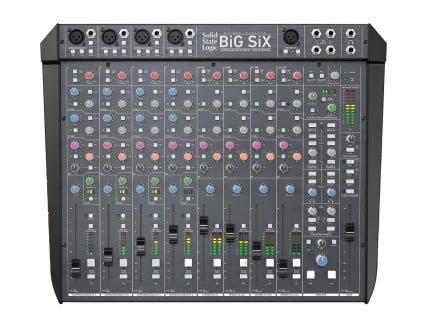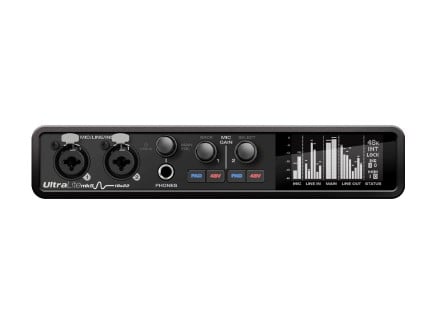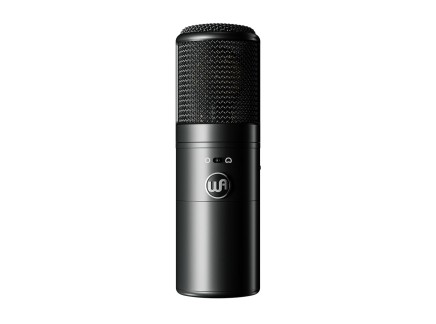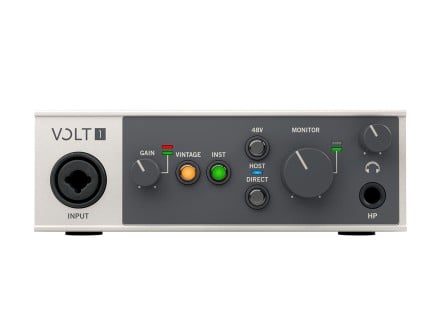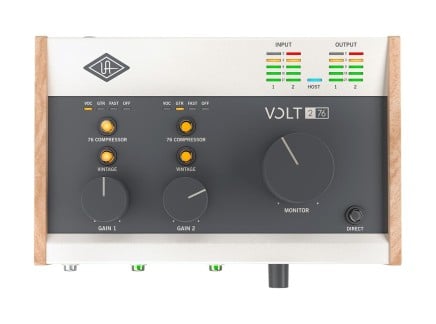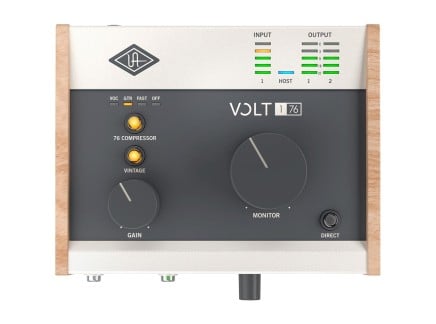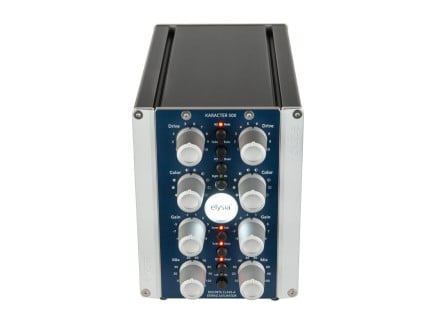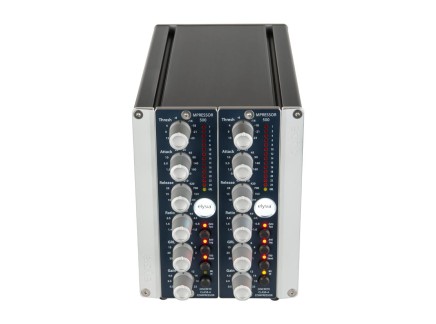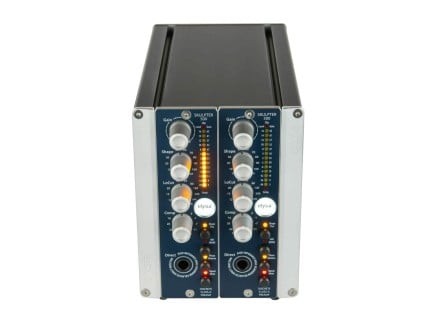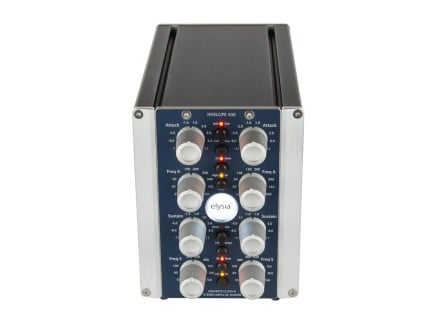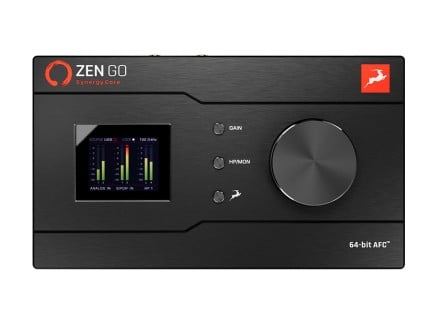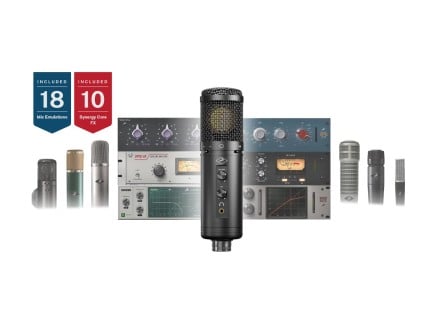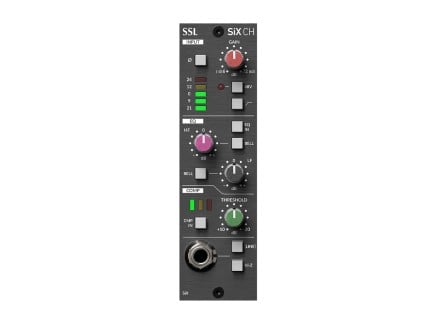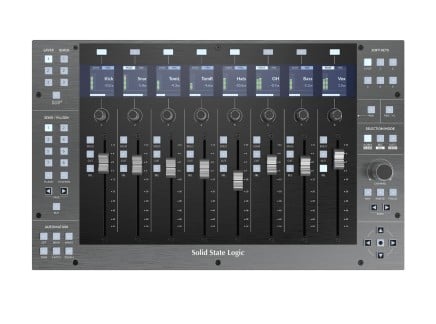Looking back on a year of awesome gear, we have to take note of all the amazing studio offerings that emerged, from affordable new interfaces to hybrid studio hubs and reissues of classic microphones. As with our recent reviews of 2021's best synthesizers and 2021's best effect pedals, we're astonished at all of the amazing tools that are now available—and we want to share some of our favorites with you.
From SSL's BiG SiX hybrid console to Universal Audio's VOLT line of budget audio interfaces, there's an awful lot to talk about...and happily, much of it falls in line with budgets appropriate to any studio or live performer. Let's dig in!
Ryan's Pick: SSL's BiG SiX
We've been a huge fan of SSL's SiX since its release in 2019; small desktop mixers are almost always part of an electronic musician's workflow, and before SiX came along, the options for truly studio-quality analog desktop mixers were scarce. SiX quickly became our go-to for a wide range of purposes, from small desktop setups to warming up our recordings in a variety of ways. As such, I was thrilled to see SSL's BiG SiX—a new mixer/small console that significantly expands on the possibilities of its predecessor. In fact, I feel like BiG SiX may be one of the most interesting mixer/interface options in its price range, making it an ideal hub of control and I/O for small studios and home recording setups.
BiG SiX expands the original SiX's channel count (for a total of eighteen channels of analog summing). It features eight primary channels—four mono channels with SuperAnalogue mic preamp and single-knob SSL compressor and four additional stereo channels. Each channel features adjustable gain or trim, two stereo cue sends, a three-band SSL equalizer, pan control, 100mm fader, 8-segment LED VU display, and dedicated Mute/Bus B and PFL controls. The Cue section allows for extensive routing option—great for creating FX sends, monitor sends, or even independent headphone mixes when you're tracking. An integrated Talkback mic input (with switchable phantom power and LMC compressor) makes it dead simple to communicate with musicians, and the switchable integrated G-Series Bus Compressor adds a satisfying analog glue to any mix. There are balanced inserts for the four mono SuperAnalogue channels, an alternate mix output, two dedicated stereo external inputs, and more routing options than we can possibly cover in the scope of this short article.
Hypothetically, we could end the conversation here and say that BiG SiX is an amazing analog mixer that gives you the sound and flexibility that you might expect from a considerably more expensive console—and that would be truthful. If you have a need for a high-end, no-nonsense mixer for your studio, this will absolutely do the trick; it'll take whatever you throw at it and make it absolutely gel. But perhaps the most impressive (and most unexpected) feature of the BiG SiX is also its most important: it's a comprehensive USB audio interface with 16 A/D and 16 D/A converters that can all be integrated into your workflow in an astounding number of ways. Each channel can be passed directly to your computer via USB completely independently from one another; each channel can be set up to independently receive audio via USB rather than from its own analog inputs; and even the cues and external inputs can be directly routed to/from your computer via USB, respectively.
What does this mean? Well, it means that, in addition to being a world-class analog mixer, BiG SiX could also act as your sole audio interface. It could also be used as an ultra-classy re-amping tool. It could also act as a summing mixer for your otherwise in-the-box mixes, adding a real-life cohesion and clarity difficult to approach with a computer alone. Frankly, the applications are nearly limitless, and given its flexibility, we can't wait to see how the BiG SiX winds up tying into everyone's personal studio setups.
Jacob's Picks: MOTU Ultralite Mk5 + Warm Audio WA-8000
MOTU's Ultralite series has long been a go-to choice for studios and performing electronic musicians, thanks to its stellar size-to-functionality ratio. Few interfaces pack so many channels of I/O into a package this size, not to mention its ability to function as a standalone mixer with internal DSP processing. Earlier this year, MOTU unveiled the Ultralite-Mk5, ushering in a new era with their beloved interface for those unwilling to cut corners in their portable setup. This version of the Ultralite employs premium ESS Sabre32 DACs, which are renowned for their audiophile-grade quality, but includes a number of other conveniences and improvements that are certainly most welcome.
In its small-but-mighty half-rack size, the Ultralite offers a whopping 18 channels of audio inputs, and 22 audio outputs. Of these, eight and ten respectively are analog audio ports, while the remainder are accessed via digital connections in the form of S/PDIF and ADAT optical. The headphone outputs and two microphone preamps are easily accessible on the front, with phantom power and pad options available on the latter. Beyond that, keeping an eye on your signal levels is easy thanks to the OLED display, with dedicated metering for every single channel. Plus, MIDI I/O facilitates connection to grooveboxes and controllers for a complete, all-in-one hub for music production and performance. And for all the synth-heads out there, MOTU is renowned for its interfaces containing DC-coupled outputs, allowing the transmission of control voltages from software like Max/MSP, VCV Rack, Bitwig, and more.
What's new on the fifth version of the Ultralite? For starters, MOTU has finally embraced USB-C, a change which is much appreciated as more and more computers switch over to this format. Additionally, this Ultralite is fully class-compliant, making it a perfect companion for iOS setups and any situation where drivers aren't available. But where they are, MOTU's software enables complete configuration of the Ultralite-Mk5, allowing it function as a totally standalone mixer, with onboard DSP effects to liven up the mix. The free CueMix 5 app can also be loaded up on iPad or iPhone for direct control and adjustment over the Ultralite's internal mixing features.
Electronic producers and performing artists alike have a lot to like about the Ultralite-Mk5, and it certainly seems to be MOTU's best iteration yet.
Earlier this year, our friends over at Warm Audio unveiled their latest take on a classic microphone design: the WA-8000. This particular mic design is based upon Sony's C800G, a beloved tube-condenser microphone released in the 1990s which quickly assumed its place alongside the mics of legend. But as those mics have become somewhat unobtanium both in supply and cost, some makers such as Warm Audio have stepped up to the plate and produced their own version.
The legacy of the C800G is quite the contrast to the stories of other distinguished microphones, having been released decades after many of its peers, like the Neumann U 47, for example. Not only had recording technology come a remarkably long way since the 50s and 60s, but the landscape of music itself was entirely different. Whereas the U 47 was a pivotal microphone in capturing the sounds of jazz and early rock music, the C800G came out when hip-hop, R&B, and rap were in the limelight. Contemporary tools are often key elements in producing contemporary art, and as such it's hard to isolate one without recognizing its dependence on the other. It's this rich history that the WA-8000 aims to recreate nearly 30 years later.
In keeping true to the original, the WA-8000 makes use of premium components to deliver its definitive sonic characteristics. From a Lundahl transformer to the 6AU6 tube and K67-style capsule, this microphone promises to deliver the clarity and air that made its ancestor the predominant mic of choice on chart-topping music of its time. It's even housed in a similar form factor, with the external power supply and hefty heat-sink designed to regulate temperatures for maximum performance, noise-free operation, and perfect sound. And of course, while it's historically known for being used as a vocal mic, there's a number of other uses waiting to be discovered with the WA-8000, from drums to guitar and more!
We're certain that many producers, engineers, and even vocalists are excited by the release of the WA-8000. By no means is it just a cheap clone, but more of a passionate tribute at a price that is comparably much more affordable than purchasing the original.
Iain's Pick: Universal Audio VOLT Series
Universal Audio continually raises the bar in the world of recording, and this year is no exception. Breaking into the market of low-cost recording, UA announced the Volt series, a line of affordable audio interfaces that are truly in a league of their own, offering a variety of options for musicians, podcasters, livestreamers, and a multitude of other content creators. Although there are multiple shapes and sizes, all Volts hold the same principles of high-quality sound, compact sturdiness and sleek design, and overall ease of use as found in UA's flagship Apollo series interfaces. As someone who can't yet personally justify the more costly Apollo interfaces, the Volt interfaces definitely placed UA in first place for my favorite studio gear.
Looking at their similarities, the Volt series all sport amazing combo XLR/TRS inputs that support microphone, line, and instrument signals. These inputs can be run quite clean or utilize the fantastic emulated sound of UA's 610 tube preamp via the "Vintage" button—having such a worshiped sound profile for average audio consumers and creators is a pretty profound gesture on UA's part. Additionally, you get +48V of engageable phantom power for use with your condenser microphones, a wonderful, studio-quality headphone output with direct monitoring, two TRS balanced outputs, and a robust yet stylish metal housing.The Volt 1 showcases all these features with a singular combo input, perfect for solo artists, singular podcasters, and live streamers.
If you're looking for more inputs, outputs and capabilities, you'll want to look towards the other four models, including the Volt 2, Volt 176, Volt 276, and Volt 476. The Volt 2 introduces an extra combo input, great for singer-songwriters or podcasters with guests, as well as 5-Pin DIN MIDI I/O. On the other hand, you have exact replicas of the Volt 1 & 2 with the Volt 176 and 276—the main differences here include the reformatting of dials with stylish wood siding as well as the fantastic and engageable "76" compressor. This compressor is a fully-analog circuit that is based around the UA 1176 compressor, and with three different presets, you have a wide range of uses to apply some smooth and classically shaping compression for vocals, guitar, and synths and drum machines. The Volt 476 is the largest expansion of the Volt series that adds two additional TRS line inputs as well as four TRS line outputs, which I find perfect for a compact recording and processing rig or even for monitoring through multiple speakers.
In my opinion, the best part that fully utilizes all of the Volts' amazing features is the class-compliant USB-C port. The USB-C factor offers high-speed transfers of the quality A/D and D/A, and their class-compliance means that they're compatible with not only Mac and Windows OS, but also iOS devices. If you're looking to get started in recording, you might want to look at the Volt 2 Studio Pack or Volt 276 Studio Pack: these packages include the interface, a condenser microphone, studio headphones and all the necessary cables. In fact, these bundles even include a software bundle with titles from Ableton, Celemony, and more...giving you truly everything that you need to get started recording. Just add a computer or iOS device and you're good to go! It's truly invaluable to have tonal shaping tools you can commit to before you further process your sound in a DAW or audio editing environment, and I think that the UA Volt series gives you that flexibility and more for a fraction of the price you might pay from other companies.
Brian's Picks: Elysia's Qube Series
If you run a studio or are into modular synths, chances are you have peered into the world of modular recording, via the 500 series format. Much like Eurorack, you can customize your perfect recording studio experience: if you record a lot of acoustic instruments, you can load up a rack of preamps; if you do more mixing, grab a few different EQs and compressors; and of course, if you are a bit of an recording experimentalist, you can fill your rack with colorful effects. But what if you are looking to just get one or two pieces of outboard gear and don't want to invest in a whole other rack—or don't have the space? The Qube series from Elysia is the solution.
Known for creating exceptional 19" rackmount units and high fidelity 500 series modules, Elysia has created something that lies somewhere between these two in a category all its own. First introduced in 2020, the Qube line wraps their most popular 500 series modules in a self-contained powered enclosure, giving you the freedom to take powerful outboard tools with you no matter where you go, or easily tuck that missing piece onto your desk.
Elysia's entire 500 series lineup is available in the Qube with their normally single channel offerings—the skulpter and mpressor—coming as a pair for either stereo or dual mono operation. Adding mastering-grade saturation with the karacter qube or open, clean tone shaping with the xfilter qube no longer requires a full 500 series rack or 19" rack. If you are focused on mostly digital engineering, producing, mixing, or mastering, having the option to add just one or two bits of outboard gear can make a world of difference to your flow and final results.
Each enclosure has a pair of XLR and 1/4" ins and outs, making it easy to interface with any audio equipment you own. At 3 pounds and with high quality power, the qubes are understated beasts that deliver pristine audio in a beautiful package. This line is perfect for any size studio, but those of us who live in small spaces, dwell in cities, or who prize minimalism will appreciate the power-to-size ratio.
Honorable Mentions + Group Favorites
Of course, 2021 had much more to offer than just these select few favorites. We were all also thrilled at the introduction of two new affordable offerings from Antelope Audio, the Zen Go Synergy Core and Axino Synergy Core USB microphone. The Zen Go Synergy Core is a no-nonsense, 2-in/2-out USB-C audio interface, packing the same high-quality preamps and conversion you'd expect from Antelope. The build is remarkable and it's designed to make the process of achieving professional-level recordings easy and affordable...and frankly, it exceeds our expectations for what a $500 interface should be like. If you're looking for an interface around this price point, it's one of our top recommendations. The Axino Synergy Core USB microphone packs the same sort of performance into a high-quality USB microphone; and of course, the Synergy Core processing means that it is capable of accurately modeling multiple other desirable high-end mics. It also includes a variety of Synergy Core effects, great for sculpting the ideal vocal tone for your recordings.
API introduced its Select series, a product line of all-new designs including four new rackmount studio processors and two new guitar effect pedals. From the T12 two-channel tube mic preamp to the T25 two-channel tube compressor and TranZformer GTR and TranZformer CMP guitar effect pedals, this series is an assortment of useful utilities that bring API's high audio standards to entirely new styles of circuits.
And of course, the BiG SiX wasn't SSL's only new product this year: the new UF8 DAW control surface and UC1 channel strip/bus compressor controller have revolutionized the way that many of us mix in the box, while the SiX Channel and Ultraviolet EQ 500 series modules have added much-welcome new flavors to our lunchboxes.
Looking back, 2021 was full of audio surprises—making it possible for any size studio to make significant upgrades to the quality of their productions. Whether you're running a commercial studio or simply getting your own home recording setup fine-tuned, we look forward to seeing what 2022 will hold!


